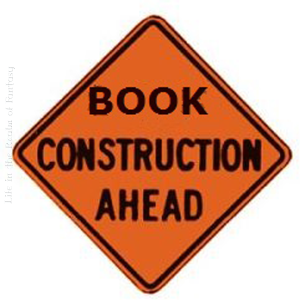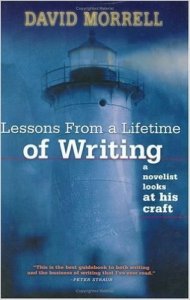 I am in the process of making revisions on my next novel, Billy Ninefingers. This book was partially written in 2013 during NaNoWriMo, but was only recently completed. Now I am deep into revisions.
I am in the process of making revisions on my next novel, Billy Ninefingers. This book was partially written in 2013 during NaNoWriMo, but was only recently completed. Now I am deep into revisions.
Most authors understand that there is an arc to the overall novel–the Story Arc which consists of :
- Exposition, where we introduce our characters and their situation.
- Rising Action, where we introduce complications for the protagonist
- Climax, the high point of the action, the turning point of the narrative
- Falling Action, the regrouping and unfolding of events that will lead to the conclusion
- Resolution, in which the problems encountered by the protagonist are resolved, providing closure for the reader.
We can easily lose track of that arc when we are in the throes of writing our first draft.
Underpinning the larger story arc is another, more fundamental arc to consider. At the 2014 PNWA Conference, in his seminar on the arc of the scene, author Scott Driscoll explained how the main difference in the arc of the scene vs the overall arc of the novel is this: the end of the scene is the platform from which your next scene launches.
As you revise, keep in mind:
- Each chapter is a scene.
- These scenes have an arc to them: action and reaction.
- These arcs of action and reaction begin at point A and end at point B.
- Each launching point will land on a slightly higher point of the story arc.
If you discover that you have lost the plot of your novel, remind yourself what the original idea was. This happened to me in 2015 when I was trying to finish the book, Valley of Sorrows. The book was to wrap up Edwin’s story, but I became sidetracked with his father’s story. I ended up separating John’s story out of the book, and giving him his own novel, The Wayward Son.
In order to write Valley of Sorrows, I had to re-connect with what the story really was about, and place it in the context of the overall series:
- In the case of my derailed book, the series dealt with Edwin’s story.
- What was his problem? He was separated from his wife and child because of his task on behalf of the Goddess Aeos. He had endured losing a man who was a brother to him while he was in Mal Evol. However, things had happened in Aeoven during his absence (an attack on his family, his wife’s miscarriage and subsequent breakdown). Unfortunately, he had a task only he could do,which kept him away from his wife and son.
- Completion of his task took us to the 3rd plot point of the novel.
- Hunting the acolyte of Tauron and the final battle in Aeoven resolved the story.
- What I had to remind myself was this: No conversation could happen unless it advanced the plot of Edwin’s story. Because the World of Neveyah is an ongoing series, anything that did not pertain to Valley of Sorrows could be cut, saved, and used in a later story.
While you are doing all of this, consider the length of your chapters.This is where pacing comes into play. Remember, pacing is the rise and fall of the action, the ebb and flow of conversations.
Courtney Carpenter, writing for Writers Digest, says “Pacing is a tool that controls the speed and rhythm at which a story is told and the readers are pulled through the events. It refers to how fast or slow events in a piece unfold and how much time elapses in a scene or story.”
How long are the chapters in your novel?
 In his book, Lessons from a Lifetime of Writing: A Novelist Looks at His Craft, action/adventure author, David Morrell (creator of the Rambo character, among others), says he tries to write short chapters, so that a reader can complete one chapter (or structural unit) at one sitting.
In his book, Lessons from a Lifetime of Writing: A Novelist Looks at His Craft, action/adventure author, David Morrell (creator of the Rambo character, among others), says he tries to write short chapters, so that a reader can complete one chapter (or structural unit) at one sitting.
He bases his ideas on two essays by Edgar Allen Poe, “The Philosophy of Composition” and “The Poetic Principle.”
Part of this is about pacing, because it’s about keeping the reader’s attention. Morrell says he keeps his structural units small in order to accommodate the reader’s bladder, TV interruptions, phone calls, a neighbor who drops in, etc.
Each chapter should be as long as it needs to be for your novel. Write what works for you, but as a reader I suggest you consider shorter chapters which can be read at one sitting.
For an excellent article on pacing, go to:
7 Tools For Pacing A Novel & Keeping Your Story Moving At The Right Pace, Courtney Carpenter, WritersDigest. com Apr. 24, 2012 (accessed Jan 29, 2017)








Great advice, as always.
My first epic fantasy has long chapters, with scene breaks within the chapters, so more than one scene in each chapter as paperbacks did a decade or two ago. However, I’ve noticed since reading extensively on my Kindle (rather than paper books), I far prefer reading shorter chapters. It gives me more of a sense of achievement of moving forward through the book, and so I now write shorter chapters too.
My first book (130K words) has around 20 chapters, while the second (150K words) has more like 45, and I think it makes it more reader-friendly. As you point out, each chapter is now an individual scene, making them far simpler to structure.
LikeLiked by 1 person
@Deborah – I hadn’t thought about that, but I think you’re right in regard to reading on the Kindle. I really like what David Morrell had to say about chapters and pacing in his book, which I believe is out of print right now, but some copies are available from second hand sources.
LikeLiked by 1 person
Behold! I am blogging on MY epic fantasy today! Await the amazing results!
(BTW, 10,245 doesn’t seem like enough words for an epic fantasy.)
LikeLiked by 1 person
If it’s an epic SHORT STORY, it might be!
LikeLike
Can a “short” story ever be epic?
LikeLiked by 1 person
Pingback: #amwriting: Revisions — Life in the Realm of Fantasy | Arrowhead Freelance and Publishing